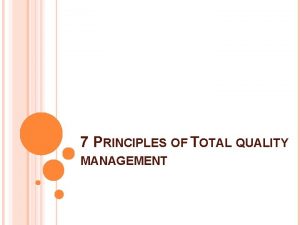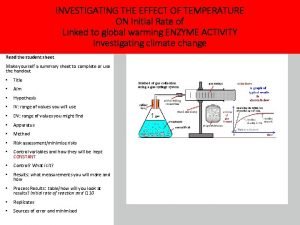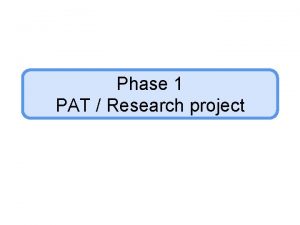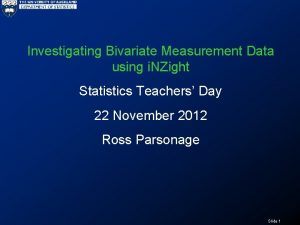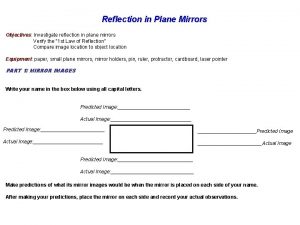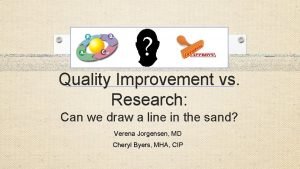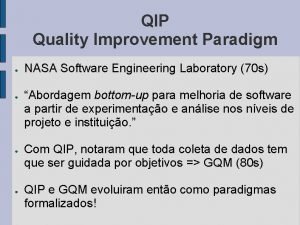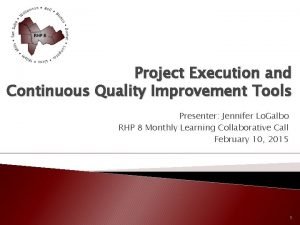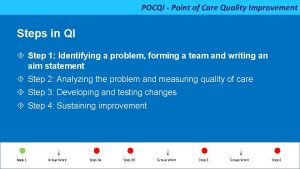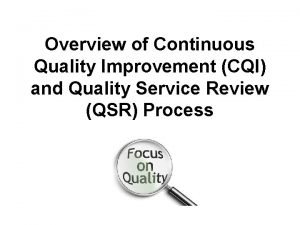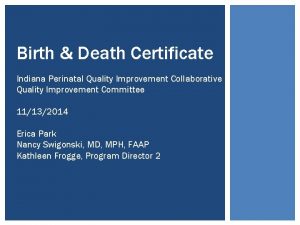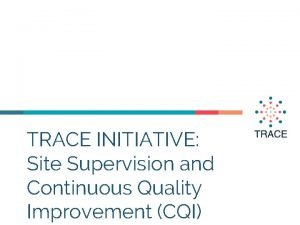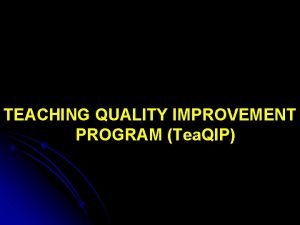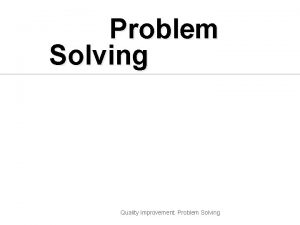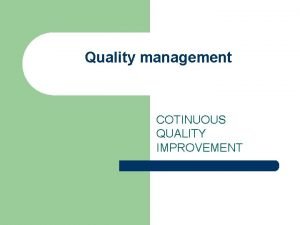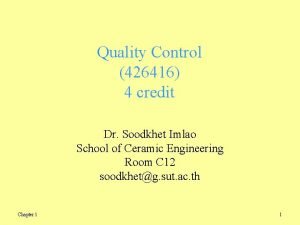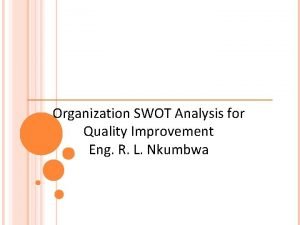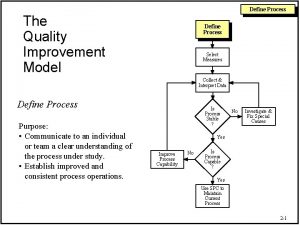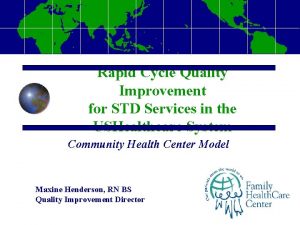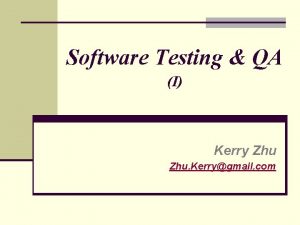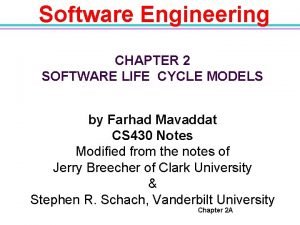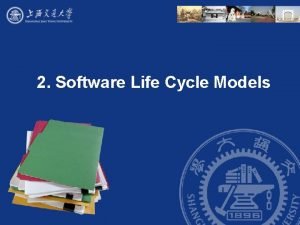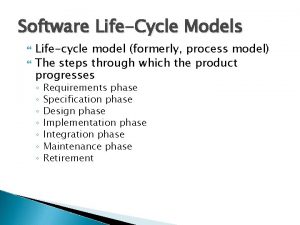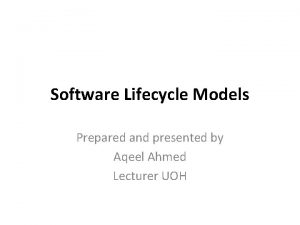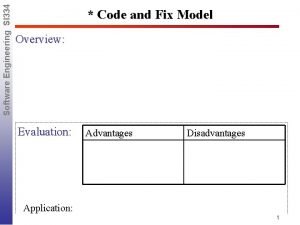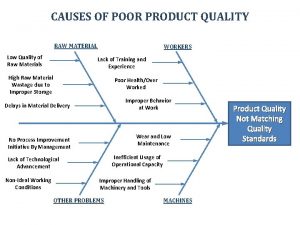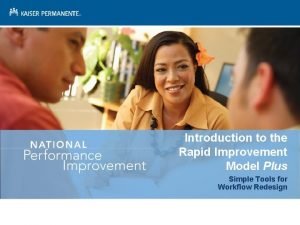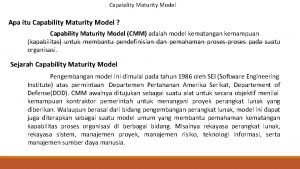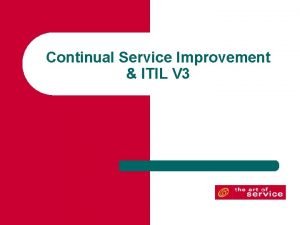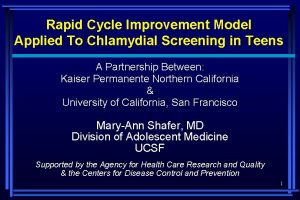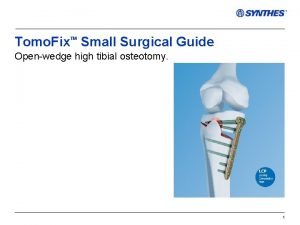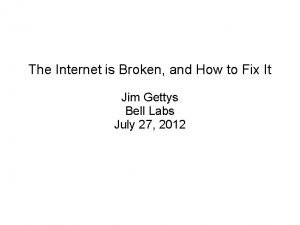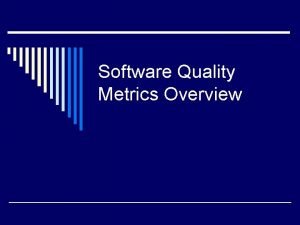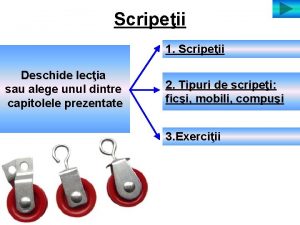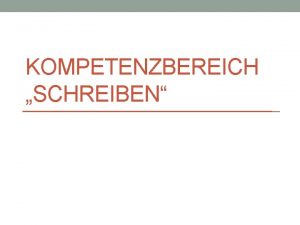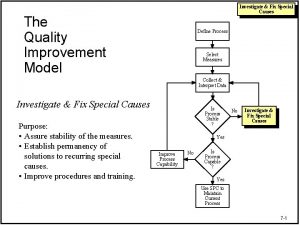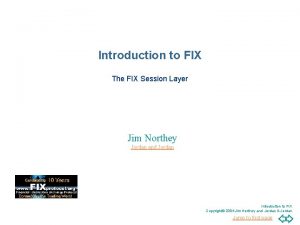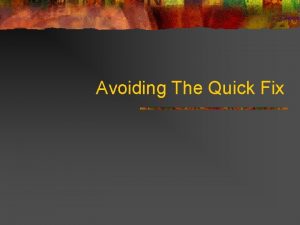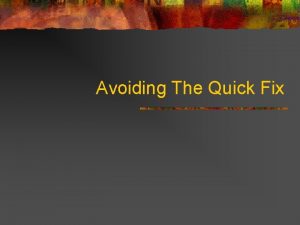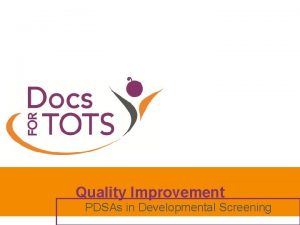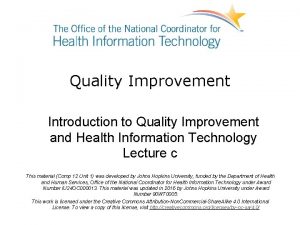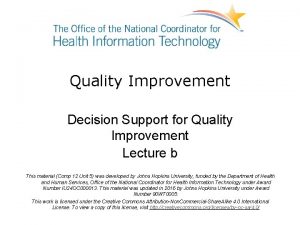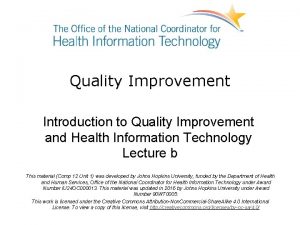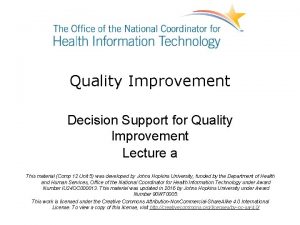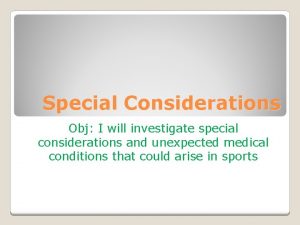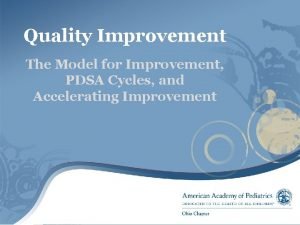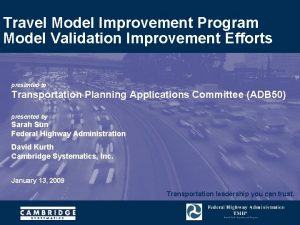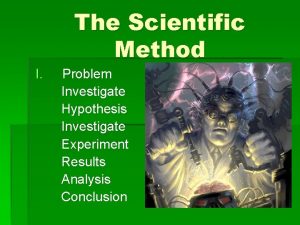Investigate Fix Special Causes The Quality Improvement Model

































































- Slides: 65

Investigate & Fix Special Causes The Quality Improvement Model Define Process Select Measures Collect & Interpret Data Investigate & Fix Special Causes Purpose: • Assure stability of the measures. • Establish permanency of solutions to recurring special causes. • Improve procedures and training. Is Process Stable ? No Investigate & Fix Special Causes Yes Improve Process Capability No Is Process Capable ? Yes Use SPC to Maintain Current Process 7 -1

Investigate & Fix Special Causes Unstable Process Control Chart UCL Quality Characteristic CL LCL Time How do we improve an unstable process? 7 -2

Investigate & Fix Special Causes Potential Special Causes Lack of standardization l Lack of consistent process conditions l Uncontrolled process variables § Unknown process variables § Fluctuating business environment § Equipment malfunctions § l Unstable measurement process l Changes in process inputs 7 -3

Investigate & Fix Special Causes The Improvement Process Diagnose Study the Symptoms § Theorize Causes § Establish True Causes § Solve Propose Alternative Solutions § Select & Apply Solution § Maintain Improvements § We must take the time to identify the cause before attempting to solve the problem. 7 -4

Investigate & Fix Special Causes Special Cause Action Plan (S. C. A. P. ) A planned sequence of activities for investigating and taking action on a problem which has been detected. l Provides a prioritized listing of potential special causes. l The S. C. A. P. should be updated whenever necessary. l Actions 1) 2) 3) 4) 5) Investigation Compensation Documentation Correction Prevention Note: This is the most important part in implementing S. P. C. 7 -5

Investigate & Fix Special Causes Investigative Action Systematic “detective” work to determine the root source of the special cause. The investigative actions should be directed toward determining: l l What When Why Where Unless the urgency of special cause dictates other action, investigative action should precede any other actions. Regardless of the urgency, investigative action should always be taken at some point. Note: This is the most important part of the S. C. A. P. . 7 -6

Compensating Action Investigate & Fix Special Causes Adjustment made to the process after a nonconformity, defect, or other undesirable process situation in an attempt to restore the process to the desired state, without addressing the underlying cause of the situation. (ISO definition) • Taking action on the process in the form of adjustments to the process. These actions do not remove the cause but are known to adjust the process in a favorable direction. (Adjusting) OR • Taking action on the process to remove the symptom of the special cause. This may not prevent the same problem from recurring in the future. (Fixing) Adjustments may help one part of the process but could be detrimental to others. 7 -7

Investigate & Fix Special Causes Documentation Recording the suspected cause of the problem, what actions were taken and how effective the action was. Benefits: • • 7 -8

Investigate & Fix Special Causes Pareto of Causes Frequency of Occurrence Cause D Note: Cause G Cause A Cause B Cause N All others Putting resources to eliminating Cause D will result in most significant Impact on process improvement. 7 -9

Investigate & Fix Special Causes Corrective Actions taken to eliminate the causes of existing nonconformity, defect, or other undesirable situation in order to prevent recurrence (ISO definition). • Permanent removal of the root source of recurring special causes that have been identified. Focus is on preventing major recurring special causes. Implementation results in variability reduction. 7 -10

Investigate & Fix Special Causes Preventive Action taken to eliminate the causes of a potential nonconformity, defect, or other undesirable situation in order to prevent occurrence. (ISO definition) • Permanent removal of the root source of a potential special cause that could affect the process. May involve using learning's from one process on another process where the special cause might also occur. 7 -11

Investigate & Fix Special Causes Control To A Standard • A standard way to perform a task. • A standard range that a key process variable should be within. • Standards should be audited. Note: S. O. P. 's NOT being followed can be a major reason for instabilities on control charts! 7 -12

Investigate & Fix Special Causes Why S. C. A. P. 's? • Control "Charts" will NOT improve the process! • S. C. A. P's IMPROVE the process • Provide a procedure for operations to follow in identifying and removing the special cause symptom. • Promote a standardized approach to investigating and compensating for special causes. • Provide a vehicle for documenting causes found actions taken to aid in future problem solving. 7 -13

Remember The C&E Matrix Investigate & Fix Special Causes Note: C&E is a good place to start building control strategies. This information will be used to develop a Failure Modes Effect Analysis (FMEA) … 7 -14

A Tool for Developing SCAP's Investigate & Fix Special Causes Failure Modes and Effects Analysis 7 -15

FMEA Definition Investigate & Fix Special Causes l A structured approach to: § Assist in developing SCAP's § identifying the ways in which a product or process can fail § estimating the risk associated with specific causes § prioritizing the actions that should be taken to reduce the risk § evaluating the design validation plan (product) or the current control plan (process) l Primary Directive: Identify ways the product or process can fail and eliminate or reduce the risk of failure 7 -16

Where Do Risks Come From? Unclear Customer Expectations Potential Safety Hazards Investigate & Fix Special Causes Poor Control Plans & SOP’s Poor Process Capability Cumulative Risk Raw Material Variation Vague Workmanship Standards Machine Reliability Measurement Variation (Online and QC) Poorly Developed Specification Limits D. H. Stamatis, FMEA: FMEA from Theory to Practice, Quality Press, 1995 7 -17

Role of FMEA Investigate & Fix Special Causes l Key tool of process team to improve the process in a preemptive manner (before failures occur) l Used to prioritize resources to insure process improvement efforts are beneficial to customer l Used to document completion of projects l Should be a dynamic document, continually reviewed, amended, updated 7 -18

Purposes of FMEA Investigate & Fix Special Causes l Analyzes new processes l Identifies deficiencies in the process control plan l Establishes the priority of actions l Evaluates the risk of process changes l Identifies potential variables to consider in Exploratory Data Analyses (EDA) and Design of Experiments (DOE) studies l Guides the development of new processes l Helps set the stage for breakthrough 7 -19

FMEA Inputs and Outputs Investigate & Fix Special Causes l Inputs § Process map § C&E matrix § Process history § Process technical procedures l Outputs § List of actions to prevent causes or to detect failure modes § History of actions taken 7 -20

FMEA Team l Team approach is necessary l Recommended representatives: § Design § Practitioners / Operators / Supervisors § Quality § Reliability § Maintenance § Materials § Testing § Supplier Investigate & Fix Special Causes 7 -21

FMEA Terms l Failure Mode l Effect l Cause l Current Controls l Severity, Occurrence, Detection l Risk Priority Number (RPN) Investigate & Fix Special Causes Next, Going to define each of these terms… 7 -22

Investigate & Fix Special Causes FMEA Exercise l As we go through the different definitions and terms, complete the form below for your process Input Failure Mode Effects Causes Controls 7 -23

Failure Mode - Definition l l l Investigate & Fix Special Causes Failure Mode - the way in which a specific process input fails if not detected and either corrected or removed, will cause the effect to occur Can be associated with a defect (in discrete manufacturing) or a process input variable that goes outside of specification o Anything that an operator can see that’s wrong is considered a failure mode Examples o Incorrect PO number o Sample Size too small o Dropped call (customer service) o Temperature too high o Surface contamination o Paint too thin 7 -24

Effect - Definition l Effect - impact on customer requirements § l Investigate & Fix Special Causes Generally external customer focus, but can also include downstream processes Examples § § § Incorrect PO number: Accounts receivable traceability errors Dropped call: Customer dissatisfaction Temperature too high: Paint cracks Surface contamination: Poor adhesion Paint too thin: Poor coverage 7 -25

Cause - Definition l Investigate & Fix Special Causes Cause Sources of process variation that causes the failure mode to occur § Identification of causes should start with failure modes associated with the highest severity ratings § l Examples § § § Incorrect PO number: Typographical error Dropped call: Insufficient number of CS representatives Temperature too high: Thermocouple out of calibration Surface contamination: Overhead hoist systems Paint too thin: High solvent content 7 -26

Current Controls - Definition l Investigate & Fix Special Causes Current Controls Systematized methods/devices in place to prevent or detect failure modes or causes (before causing effects) § Prevention consists of mistake proofing, automated control and set-up verifications § Controls consist of audits, checklists, inspection, laboratory testing, training, SOP’s, preventive maintenance, etc. § 7 -27

Investigate & Fix Special Causes Linking Failure Modes to Effects Failure Mode 1 Effect 1 Failure Mode 2 Effect 1 Failure Mode 1 Effect 2 Note that the relationship between the failure mode and the effect is not always 1 -to-1 7 -28

Risk Priority Number (RPN) Investigate & Fix Special Causes The output of an FMEA is the Risk Priority Number l The RPN is a calculated number based on information you provide regarding o the potential failure modes, o the effects, and o the current ability of the process to detect the failures before reaching the customer l It is calculated as the product of three quantitative ratings, each one related to the effects, causes, and controls: l RPN = Severity X Occurrence X Detection Effects Causes Controls 7 -29

Definition of RPN Terms Investigate & Fix Special Causes Severity (of Effect)- importance of effect on customer requirements - could also be concerned with safety and other risks if failure occurs (1=Not Severe, 10=Very Severe) l Occurrence (of Cause)- frequency with which a given cause occurs and creates a failure mode. Can sometimes refer to the frequency of a failure mode (1=Not Likely, 10=Very Likely) l Detection (capability of Current Controls) - ability of current control scheme to detect or prevent: l the causes before creating failure mode § the failure modes before causing effect § 1=Likely to Detect, 10=Not Likely at all to Detect § 7 -30

"Example" Rating Scale Detection is typically assumed to imply action can be taken Investigate & Fix Special Causes 7 -31

Quiz! Investigate & Fix Special Causes Take 5 minutes to fill in the results and what action should be taken. Be prepared to discuss results. 7 -32

FMEA Form - Initial Assessment Investigate & Fix Special Causes 7 -33

FMEA Form - Long Term History Investigate & Fix Special Causes 7 -34

FMEA Methodology Investigate & Fix Special Causes l Two major approaches: § Starting with Cause & Effect Matrix § Starting with FMEA directly from the Process Map l We will explain the approach using the C&E matrix, though both approaches are very similar l Spreadsheet tools have been prepared to assist you in the preparation of the FMEA 7 -35

FMEA Methodology - Starting with C&E Matrix l Investigate & Fix Special Causes Advantage: The Cause & Effect Matrix assists the team in defining the important issues that the FMEA should address by helping to prioritize important customer requirements § Process inputs that could potentially impact these requirements § Prioritizing the Key Process Inputs according to their impact on the Output variables (We want to focus on Inputs that highly impact a large number of Outputs first § The C&E Matrix also provides quantitative output that can be used in the determination of the specific severity ratings for the next stage of the FMEA process 7 -36

FMEA - Step by Step Investigate & Fix Special Causes 1. For each process input, determine the ways in which the input can go wrong (failure modes) 2. For each failure mode associated with the inputs, determine effects of the failures on the customer Remember the internal customers! 3. 4. 5. 6. Identify potential causes of each failure mode List the Current Controls for each cause or failure mode Create Severity, Occurrence, and Detection rating scales Assign Severity, Occurrence and Detection ratings to each cause 7. Calculate RPN’s for each cause 8. Determine recommended actions to reduce high RPN’s 9. Take appropriate actions and recalculate RPN’s 7 -37

Investigate & Fix Special Causes Process Mapping Examples Manufacturing Inputs Outputs Types Total Rate Mixer Speed Al 2 O 3 Qual Rec Comp C C U U Ext Rate Die Wear Ext RPMs Die Change C U Temperature C Rot speed C Draft C Feed Rate C Drying air U Mixing Water and Metals Preparation Extrusion Extrude through die Inputs • TV of Mix Quality Check around extrusion Nitric Acid H 2 O 2 Water ADM Hold Time Agitation C C U C • TV of Mix Quality Check around extrusion Phos Acid Nozzle Type Spray Time Water Moly Nickel Base C C C C Dryer Calciner • Surface Area Material drying, surface area issues • Pore Volume • Appearance Outputs Types Temperature C Rate C Air Flow C Res Time C NADM Solution Preparation Impregnation • • p. H Temp Specific Gravity Clarity Metals addition • Appearance (Color, Wetness) Fluid Bed Dryer Final preparation / appearance issues • Appearance (Color) • Physical Chemical Properties • Cycle Time (plugging) • Zone 3 Temp 7 -38

C&E Matrix Example l Investigate & Fix Special Causes This is the C&E Matrix for the previous Manufacturing Process Map with the Key Inputs sorted by the Total Score 7 -39

FMEA Worksheet Investigate & Fix Special Causes Before we move to the example let’s look at an FMEA worksheet The information on this sheet is transferred directly to the FMEA form The purpose of this worksheet is to focus the team on the FMEA inputs and not on scoring The scoring should be done after the basic inputs have been made FMEA Worksheet. XLS 7 -40

FMEA Step 1 Investigate & Fix Special Causes 1. For Each Process Input, Determine the Ways in Which the Input Can Go Wrong (Failure Modes) We will first deal with the Moly Flow Rate input variable. 7 -41

FMEA Step 2 Investigate & Fix Special Causes 2. For Each Failure Mode Associated with the Inputs, Determine Effects These effects are internal requirements for the next process and/or to the final customer 7 -42

FMEA Step 3 Investigate & Fix Special Causes 3. Identify Potential Causes of Each Failure Mode In most cases, there will be more than one Cause for a Failure Mode but we’ll keep it simple for this exercise May elect to list both effects on a single line since they relate to a single cause, and reduce a line in the table. 7 -43

FMEA Step 4 Investigate & Fix Special Causes 4. List the Current Controls for Each Cause For each failure mode/cause we list how we are either preventing the cause or detecting the failure mode We will list the procedure number where we have a SOP We need to be considerate of “holes” in the current controls column…. . in this example, there are controls on the operation 7 -44

Investigate & Fix Special Causes FMEA Step 5 5. Create Severity, Occurrence, and Detection Rating Scales Example Rating Scale 7 -45

FMEA Step 6 Investigate & Fix Special Causes 6. Assign Severity, Occurrence and Detection Ratings to Each Cause We are now ready to transfer the worksheet input to the FMEA form l Copy and paste the worksheet columns into the appropriate FMEA form columns l The team then starts scoring each row to compute the RPN values l Notes: l You will only use one Severity value § Determine which effect has the highest associated Severity and use that SEV value for ALL causes for the related failure mode (Worst Case) § o When combining effects that have the same cause … Next Slide 7 -46

FMEA Step 6 Continued… Investigate & Fix Special Causes 6. RPN Component Value Assignment If you chose to combine these and put both the Off-Spec Material and Plugs dryer in a single effects block, then the SEV score should be 10. 7 -47

FMEA Step 7 Investigate & Fix Special Causes 7. Calculate RPNs • Multiply the Severity, Occurrence, and Detection values for each line in the FMEA • The Excel form automatically calculates the RPN for you • Then sort all lines by RPN • Notice that you have to identify all cells so you can carry the failure modes, effects, causes and current controls along with the sort 7 -48

RPN Review Investigate & Fix Special Causes l Once you calculate the RPN for each failure mode / cause / controls combination, review the results and look for insights § Do the gut check - does the Pareto of items make sense? § If not, maybe the ratings given are varying l Determine potential next steps: § Data collection § Experiments § Process improvements § Process control implementations 7 -49

Investigate & Fix Special Causes FMEA Step 8 8. Determine Recommended Actions to Reduce High RPN’s Now fill in recommended actions for top RPNs Actions are recommended for only the high RPN’s The key is FOCUS! FOCUS 7 -50

FMEA Step 9 Investigate & Fix Special Causes 9. Take Appropriate Actions and Recalculate RPNs We have recorded the action taken and the impact on the RPN Notice that this is a nice way to track past activities The FMEA should be re-evaluated by the group as new recommended actions are identified, completed and recorded 7 -51

B-326 DI FMEA Example Investigate & Fix Special Causes 7 -52

B-326 DI FMEA Example Investigate & Fix Special Causes 7 -53

Approaches to FMEA Investigate & Fix Special Causes l Approach One (C&E Matrix Focus) § Start with key inputs with the highest scores from the C&E Matrix analysis § Fill out the FMEA worksheet for those Inputs § Calculate RPN’s and develop recommended actions for the highest RPN’s § Complete the Process FMEA for other Inputs over time l Approach Two (Customer Focused) § Fill out the failure mode and effects columns of the worksheet. Copy to FMEA form and rate Severity. § For High Severity Ratings, List causes and rate Occurrence for each Cause § For the highest Severity * Occurrence Ratings, evaluate current controls § For Highest RPN’s develop recommended actions 7 -54

Approaches to FMEA Continued… Investigate & Fix Special Causes l Approach Three (Comprehensive) § Good approach for small processes § Fill out the FMEA worksheet beginning with the first process step and ending with the last § Score SEV, OCC and DET for all causes § Develop recommended actions for highest RPN’s l Approach Four (Super Focused) § Pick the top Pareto defect item (Damaged Components) or Failure Mode (Variability in Temperature) § Focus the FMEA process on only that defect or failure mode § Purpose: To “kill” that failure mode 7 -55

FMEA Overview Investigate & Fix Special Causes How Bad? What is the Input What can go wrong with the Input? What is the Effect on the Outputs? How Often? What are the Causes? How can these be found or prevented? How well? What can be done? 7 -56

S. C. A. P. Considerations Investigate & Fix Special Causes 1) A single joint is above UCL or below LCL 2) A run of 8 above or below CL Bad 1) Sporadic Problems Better Time 2) Chronic Problems Target Time Note: S. C. A. P. may need to be specific to the type of instability 7 -57

A “Typical” S. C. A. P. Investigate & Fix Special Causes Plot Data on Control Chart Signal? No Yes Recheck Lab Analysis Recheck Value Inside Control Chart Limits? Yes • Delete Original Value • Replace With “New” Value No • Adjust Process Variable (Knob) • Wait for Another Sample No Next Sample Value Inside Control Chart Limits? Yes 7 -58

Investigate & Fix Special Causes A “Suggested” S. C. A. P. Plot data on Control Chart Compensating Action Yes Control Chart Signal? Laboratory Control Strategy No Yes Production Control Strategy Is Adjustment Process Variable Appropriate? Yes No No Adjust Process Variable and Collect Another Sample as Soon as Appropriate. Yes Is Another Adjustment Called for? Stability Yes Restored? Continue to Monitor No Document Actions & Results Documentation • Process Operating Conditions • Equipment Failure • Raw Material Change • Procedure Deviation All OK? No Investigative Action Correct Process and Collect Another Sample as Soon as Appropriate Continue to Monitor Yes Continue to Monitor No Yes “Last Resort” Adjustments Stability Restored? Corrective Action Document all Actions, Results and Additional Observations Documentation Document Actions & Results Documentation Preventive Action 7 -59

Investigate & Fix Special Causes Special Cause Detected By Production Control Chart No Does Control Strategy Direct Investigating for Special Cause in Laboratory? Yes Was Data Recorded Correctly? No Measurement System Investigation Yes Correct Error Report Corrected Results to Production Notify Production of Lab Problem Find and Correct Special Cause in Measurement Process (Precision Monitoring) Discard Original Test Results Retest Sample Notify Production of Lab Problem Find and Correct Special Cause in Measurement Process (Accuracy Monitoring) Discard Original Test Results Retest Sample Test Results Confirmed? Is Range Between Test Results Less Than 3. 7 s. M? No Yes Measurement Process Stable? (Accuracy Monitoring) No Yes Report Initial Test Result To Production Check for Special Cause in Production Process 7 -60

S. C. A. P. Check Sheet Example Investigate & Fix Special Causes 7 -61

Knowledge/Systems Requirements for a S. C. A. P. Investigate & Fix Special Causes Compensating Action • Criteria for judging if compensating action is appropriate. • What process variable is to be adjusted? • Required effect of process variable adjustment. • Amount of adjustment to obtain the required effect. • Criteria for judging if stability has been restored. Investigative Action • Standard (Required) Process Operating Conditions. • Equipment failures signals. • Raw material analysis techniques. • Well-defined procedures. Corrective Action • Well-defined procedures for correcting any deviation detected in the Investigative Action. • “Last Resort” adjustment procedures. • Criteria for judging if stability has been restored. Documentation • Procedures/Systems for documenting actions, results and additional observations. • Procedures, Lists, charts for accumulating actions, results and additional observations. 7 -62

Investigate & Fix Special Causes S. C. A. P. • Control Charts provide information, I. e. , when to take action and when not to take action. • People must know what action to take. Actions need to be standardized for all people. • People control the process, not the control charts. • Investigation of Assignable Causes and the correction/ prevention of problems should never end. • Control Charts and the S. C. A. P. need to be reviewed periodically and updated as needed. • Process Control is the responsibility of Operations. Control Charts need to be in the hands of the people who control the process. 7 -63

Investigate & Fix Special Causes Statistical Process Control Define Process Select Measures Statistical Process Control (SPC) is a collection of activities: • Selection of appropriate process measures • Collection of process data • Graphical analysis of data • Analysis of process stability • Use of data to investigate and fix special causes in a continuous improvement cycle Collect & Interpret Data Is Process Stable ? No Investigate & Fix Special Causes Yes Improve Process Capability No Is Process Capable ? Yes Use SPC to Maintain Current Process 7 -64

Investigate & Fix Special Causes Exercises 1. ) Your Catapult Team should complete page 10 of the “Catapult Process” handout. Limit yourselves to 30 minutes for this exercise. 7 -65
 Define quality assurance in nursing
Define quality assurance in nursing Compliance vs quality
Compliance vs quality 7 concepts of tqm
7 concepts of tqm Lesson 4 parameters and return make
Lesson 4 parameters and return make What is jocasta doing the next time she leaves the palace?
What is jocasta doing the next time she leaves the palace? How to calculate initial rate of reaction
How to calculate initial rate of reaction How to investigate a problem
How to investigate a problem Investigate bivariate measurement data
Investigate bivariate measurement data Investigate reflection
Investigate reflection Quality improvement vs research
Quality improvement vs research Qsen standards
Qsen standards Quality improvement paradigm
Quality improvement paradigm Define continuous quality improvement
Define continuous quality improvement Pocqi ppt
Pocqi ppt Define continuous quality improvement
Define continuous quality improvement Efmd quality improvement system
Efmd quality improvement system Indiana perinatal quality improvement collaborative
Indiana perinatal quality improvement collaborative Continuous quality improvement program planning worksheet
Continuous quality improvement program planning worksheet Tea quality improvement
Tea quality improvement Xerox problem solving process
Xerox problem solving process Sustainability in quality improvement
Sustainability in quality improvement Quality improvement nurse
Quality improvement nurse Quality improvement
Quality improvement Juran 10 steps to quality improvement
Juran 10 steps to quality improvement Swot analysis quality improvement
Swot analysis quality improvement Malnutrition quality improvement initiative
Malnutrition quality improvement initiative Quality improvement
Quality improvement Data driven quality improvement
Data driven quality improvement Rapid cycle quality improvement
Rapid cycle quality improvement Crosby quality is free
Crosby quality is free Kerry zhu
Kerry zhu Feedback cycle
Feedback cycle Prototyping model
Prototyping model Object oriented life cycle model
Object oriented life cycle model Build and fix model
Build and fix model Quick fix model in software engineering
Quick fix model in software engineering Find-fix-finish-exploit-analyze targeting model
Find-fix-finish-exploit-analyze targeting model Proximate and ultimate causes of behaviour
Proximate and ultimate causes of behaviour Proximate cause ap bio
Proximate cause ap bio Causes of poor quality
Causes of poor quality Rapid cycle improvement model
Rapid cycle improvement model Florida continuous improvement model
Florida continuous improvement model Capability maturity model improvement digunakan pada bagian
Capability maturity model improvement digunakan pada bagian Pdsa cycle nursing
Pdsa cycle nursing Itil benchmark metrics
Itil benchmark metrics Rapid improvement model
Rapid improvement model Quality assurance vs quality control
Quality assurance vs quality control Pmp quality management
Pmp quality management Pmbok quality management
Pmbok quality management Concepts of quality control
Concepts of quality control Known as the fun uncle of the quality revolution
Known as the fun uncle of the quality revolution Old quality vs new quality
Old quality vs new quality Fix it first remedy
Fix it first remedy Tomo fix
Tomo fix Tamucc workday
Tamucc workday The internet is broken. how fix
The internet is broken. how fix Types of quality metrics
Types of quality metrics Scripetele compus
Scripetele compus Saks fashion fix
Saks fashion fix Sene gence deutschland
Sene gence deutschland Fix engine vendors
Fix engine vendors Converging ils
Converging ils Pleaser and controller relationship
Pleaser and controller relationship Fix up seminars
Fix up seminars Taste kelimesinin 3. hali
Taste kelimesinin 3. hali Can a biologist fix a radio
Can a biologist fix a radio


